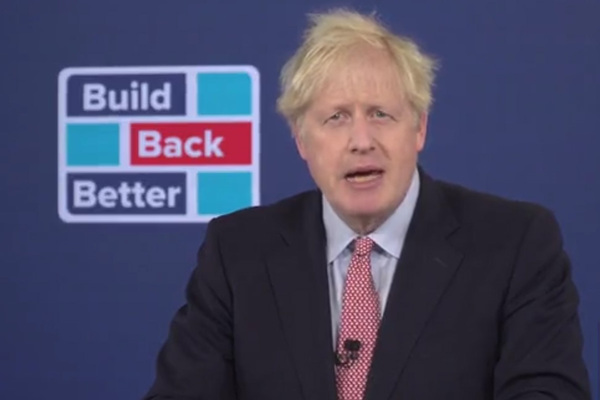You are viewing 1 of your 1 free articles
 Jules Birch
Jules BirchYou are prime minister. You have £5.8bn to spend on housing. What do you do?
The prime minister has rehashed familiar homeownership rhetoric when there are much more pressing needs for investment, writes Jules Birch
You are prime minister. You have £5.8bn to spend on housing. What do you do?
Before you answer that question, let me tell you there’s a catch: you are a Tory prime minister, so this has to be all about homeownership – even the Affordable Homes Programme.
You may have guessed by now I’m talking about decisions already taken by chancellor Rishi Sunak – decisions that are looking worse and worse the more time goes on.
But my question was prompted by the only ‘new’ idea that I’ve seen emerging from the Conservative Party conference: a plan to create ‘Generation Buy’ by encouraging low-deposit mortgages to help young people on to the housing ladder.
“It’s possible that around half of would-be first-time buyers are now excluded from the market”
This idea, revealed by Mr Johnson in a Telegraph interview on Saturday, is not especially new. Essentially, it’s a rehash of the mortgage guarantee part of Help to Buy and it harks back to the days when Gordon Brown wanted to encourage long-term, fixed-rate mortgages. It also seems to be inspired by a report published by the Centre for Policy Studies last month.
The plan does at least attempt to address the problem that loan-to-value restrictions imposed after the financial crisis have left people unable to borrow enough to buy – yet paying more in rent than they would for a mortgage.
As Neal Hudson argues, a credit crunch seen since the pandemic has led to a spike in interest rates on high loan-to-value loans and it’s possible that around half of would-be first-time buyers are now excluded from the market.
But a more relaxed regime would not help people in expensive areas to buy unless loan-to-income restrictions were also removed, which would take us right back to where we were before 2007.
The real problem is that the idea cannot be taken in isolation because of a measure already introduced by the Johnson government – because if there is a time not to introduce state-guaranteed 95% mortgages, it is surely after you’ve spent £3.8bn on inflating house prices.
Not only that, but where the stamp duty cut could have been restricted to first-time buyers – perhaps at the same time as mortgage restrictions were eased – it is instead available to all buyers, including buy-to-let ‘investors’ and owners of second homes.
There is a similar problem with another government housing policy launched last week – the £2bn Green Homes Grant scheme for homeowners to boost the energy efficiency of their homes.
Again, it’s not the worst idea in the world – the existing housing stock is a major source of carbon emissions and the work will generate new jobs. There also seem to be at least some safeguards to stop it becoming a charter for cowboy builders.
But if you wanted a strategy to decarbonise housing, you probably would not start with a free-for-all that seems to have little sense of the best ways to improve particular types of home.
“That £5.8bn is more than three times what the government is spending on a glaring problem with existing homes that has seen a key section of the housing market grind to a halt”
When you step back for a minute and put both programmes together, that £5.8bn is more than three times what the government is spending on a glaring problem with existing homes that has seen a key section of the housing market grind to a halt.
If homeownership has to be the priority, surely the place to start is the plight of the nearly 700,000 people who are stuck in buildings with dangerous cladding and 1.5 million leaseholders whose homes are un-mortgageable and unsaleable.
The £1.6bn announced so far to fix the cladding scandal does not come close to covering the costs in high-rises – and that is before you consider buildings shorter than 18 metres and all the other fire-safety problems that have emerged since Grenfell. The total cost could run to £15bn.
Housing secretary Robert Jenrick hinted over the weekend and again at parliamentary questions on Monday that he is lobbying the Treasury for more money. If true, it cannot come soon enough.
The longer term question is what will follow the boom in the housing market fuelled by the stamp duty cut?
So far the government seems intent on keeping the market moving by funding affordable homeownership schemes and making it easier for buyers to borrow more money.
If – or when – the market downturn begins, will the government have the imagination to switch strategy?
Boris Johnson’s speech to the Conservative conference on Tuesday offered no signs of it.
The housing section was all about homeownership, as he hailed his plan to turn Generation Rent into Generation Buy with long-term, fixed rate mortgages for up to 95% of the value of the home,
He said: “We believe that this policy would create two million more owner-occupiers – the biggest expansion of homeownership since the 1980s.”
“Either there is something very big that he is not telling us or this is just hot air”
Either there is something very big that he is not telling us or this is just hot air, because there is no way what he’s announced so far could achieve anything like what the selling off of millions of council houses at big discounts did back then.
There was also a noticeably hostile attitude towards the private rented sector as he presented a picture of millions locked in cramped, rented flats during the pandemic who craved the freedom of ‘the power to decide what colour you can paint your own front door’.
That is, of course, exactly what Conservatives used to say about council housing in the 1980s but more than 30 years later, it is private rather than local authority landlords making the decisions.
By stark contrast with recent Conservative conferences, the prime minister had nothing to say about affordable, let alone social or council housing and nothing to say about the cladding and leasehold scandals. That will have made all that rhetoric about homeownership ring hollow for millions.
Jules Birch, columnist, Inside Housing












